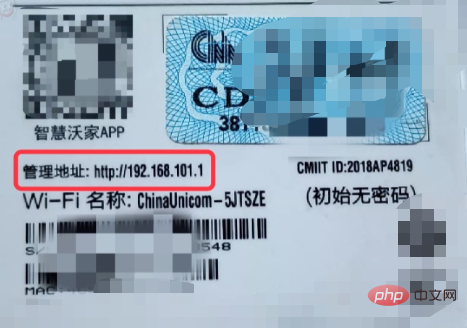What router is cu?
cu is a China Unicom router. cu is the WiFi signal emitted by China Unicom's router or smart optical modem, which means it is a router device related to China Unicom. For the initial WiFi password of the router starting with CU, you need to check the sticker on the back of each device. Since it is a customized model of router, most of the initial default passwords are "one machine, one code".

The operating environment of this tutorial: Windows 7 system, Dell G3 computer.
Router (Router) is a device that connects various LANs and WANs in the Internet. It will automatically select and set routes according to the channel conditions, and send signals in order using the best path. Routers have been widely used in all walks of life, and products of various grades have become the main force in realizing internal connections of various backbone networks, interconnection between backbone networks, and interconnection between backbone networks and the Internet.
What kind of router is cu?
cu is a router from China Unicom.
WiFi starting with CU is a customized model of China Unicom. Customized brands include many, such as Huawei, ZTE, FiberHome, 360, Xiaomi, TP-LINK and Tenda, etc. all have related customized models. Scan the QR code on the back of the router.
WiFi starting with CU is generally considered to be the WiFi signal emitted by China Unicom's router or smart optical modem, that is to say, it is a router device related to China Unicom. For the initial WiFi password of the router starting with CU, you need to check the sticker on the back of each device. Since it is a customized model of router, most of the initial default passwords are "one machine, one code". The default WiFi name and WiFi password of each router are different. 
Unicom router administrator password classification:
Same default password: admin Same brand password: such as ZTE router 507@CUcc Each device has a different password: one machine One codeThis requires us to look at the sticker on the other side of the router to confirm what the administrator password of the router is.China Unicom Router Login Portal
There are many China Unicom router login portals, because China Unicom’s routers are customized with third parties, and there are routers of various brands and models. The login management addresses are all different. The common login entrance addresses of China Unicom routers are: 192.168.101.1, 192.168.2.1, 192.168.5.1, etc...We can check the nameplate label at the bottom of the China Unicom router Get the correct login management address of the router, as shown below:For example, the management address of this China Unicom customized version of the router is http://192.168.101.1
The routers of other brands and models are different, so please refer to your own router.
For example, for the Skyworth customized router below, the default configuration management address is: 192.168.86.1 and cucc.skroute.cn
The default account is: admin and the default password is: admin
For more related knowledge, please visit the
FAQcolumn!
The above is the detailed content of What router is cu?. For more information, please follow other related articles on the PHP Chinese website!

Hot AI Tools

Undresser.AI Undress
AI-powered app for creating realistic nude photos

AI Clothes Remover
Online AI tool for removing clothes from photos.

Undress AI Tool
Undress images for free

Clothoff.io
AI clothes remover

Video Face Swap
Swap faces in any video effortlessly with our completely free AI face swap tool!

Hot Article

Hot Tools

Notepad++7.3.1
Easy-to-use and free code editor

SublimeText3 Chinese version
Chinese version, very easy to use

Zend Studio 13.0.1
Powerful PHP integrated development environment

Dreamweaver CS6
Visual web development tools

SublimeText3 Mac version
God-level code editing software (SublimeText3)

Hot Topics
 What does router sys mean?
Aug 23, 2022 am 10:42 AM
What does router sys mean?
Aug 23, 2022 am 10:42 AM
The sys of the router means system operating status indication, and the full name is System; the router uses the sys indicator light to inform the user of the operating status of the device. If the router is faulty or restarting, the indicator light will flash; the indicator light of the router can be divided into power Indicator light, sys system indicator light, LAN indicator light and WAN indicator light.
 Can the router be placed upside down?
Sep 22, 2023 pm 02:11 PM
Can the router be placed upside down?
Sep 22, 2023 pm 02:11 PM
Can. However, you need to pay attention to some issues: 1. Placing the router upside down may have a certain impact on heat dissipation, causing heat to accumulate at the bottom of the router, affecting the heat dissipation effect. Long-term overheating may reduce the performance of the router and adversely affect its lifespan. ; 2. Placing the router upside down may affect the operation and management of the device, and the indicator lights and interfaces may be blocked or inconvenient to operate; 3. Placing the router upside down may also have a certain impact on network security, and the default user name and password may cause This information is more susceptible to prying eyes.
 What does router sn mean?
Oct 27, 2022 pm 05:21 PM
What does router sn mean?
Oct 27, 2022 pm 05:21 PM
In routers, sn stands for "Serial Number", which means "serial number" and refers to the factory number of the router. The router serial number (SN) and physical address are both hardware identifiers, which are unique; the router will be under warranty only if the router's serial number is kept intact. The router serial number SN can be seen directly in the manual and on the back of the router.
 What are the benefits of turning on ipv6 on the router 'Advantages of using the latest IPv6'
Feb 06, 2024 pm 05:34 PM
What are the benefits of turning on ipv6 on the router 'Advantages of using the latest IPv6'
Feb 06, 2024 pm 05:34 PM
Students who know computers all know that if our computer wants to connect to the network, it must have an IP address. This IP address can be manually configured, such as 172.16.19.20; it can also be automatically obtained by the DHCP server of the computer network card, such as 192.168.1.100 etc. These IP addresses are what we often call IPV4 addresses, and the corresponding IPV6 is also a type of IP address. What is IPV6 IPV6 is a new IP address that emerged in response to the exhaustion of IPV4 address resources. Its full name is "Internet Protocol Version 6", and its Chinese name is the sixth generation of Internet Protocol. The number of IPv6 addresses is theoretically 2^128
 How many lights on the router are normal? 'Recommended detailed explanation of the normal status of the router indicator lights'
Feb 06, 2024 pm 09:12 PM
How many lights on the router are normal? 'Recommended detailed explanation of the normal status of the router indicator lights'
Feb 06, 2024 pm 09:12 PM
The first light is on, indicating that the router is powered on. Which port is plugged in, the light of which port is on, and flashing means data is being transmitted. Wireless routers usually have three indicator lights: SYS, LAN and WAN. When the wireless router is powered on, the SYS light will light up. When the wireless router is connected to the network modem, the WAN light will light up. The LAN light corresponds to each interface of the wireless router. As long as the network cable is inserted into the corresponding interface, the corresponding LAN light will light up. 1. If it keeps flashing, it means it is transmitted by data, and the router settings should be normal. 2. If you have always been able to access the Internet, but you can't get online recently; it is probably a problem with the external line, that is, a problem with the operator (usually there is a problem with the line, causing the data signal to attenuate too much, although the line is good)
 Which one is faster, gateway or router?
Jun 19, 2023 pm 03:06 PM
Which one is faster, gateway or router?
Jun 19, 2023 pm 03:06 PM
The difference between gateway WiFi and router WiFi is mainly reflected in three aspects: function, number of terminals that support Internet access, and WiFi signal coverage. Gateway WiFi is a combination of optical modem and router. It has more functions, but it supports fewer Internet devices and the WiFi signal coverage is not as good as router WiFi.
 Will placing the router upside down have any impact on the network?
Sep 22, 2023 pm 04:45 PM
Will placing the router upside down have any impact on the network?
Sep 22, 2023 pm 04:45 PM
Placing the router upside down may have some effects on the network, including reduced signal coverage, blocked signal transmission, poor temperature and heat dissipation, and reduced network speed. Detailed introduction: 1. The signal coverage is reduced. Routers are usually designed to radiate signals outward in a horizontal direction. Therefore, placing the router upside down may cause the signal coverage to be reduced, which may cause signal in some areas. Weakening, thus affecting the stability and speed of the connection; 2. Signal transmission is blocked. Placing the router upside down may cause signal transmission to be blocked, etc.
 Why can't I access the Internet even though I'm connected to the router?
Nov 24, 2023 pm 05:29 PM
Why can't I access the Internet even though I'm connected to the router?
Nov 24, 2023 pm 05:29 PM
Reasons why the router is connected but cannot access the Internet: 1. Internet service provider problem; 2. Router setting problem; 3. LAN problem; 4. WiFi signal problem; 5. Router hardware problem; 6. DNS problem; 7. Network cache problem ; 8. Firewall and security software issues; 9. Operator restrictions; 10. Equipment failure. Detailed introduction: 1. Internet service provider problems. This is a common reason. Internet service providers may have problems, such as network interruption or service interruption; 2. Router setting problems, etc.





